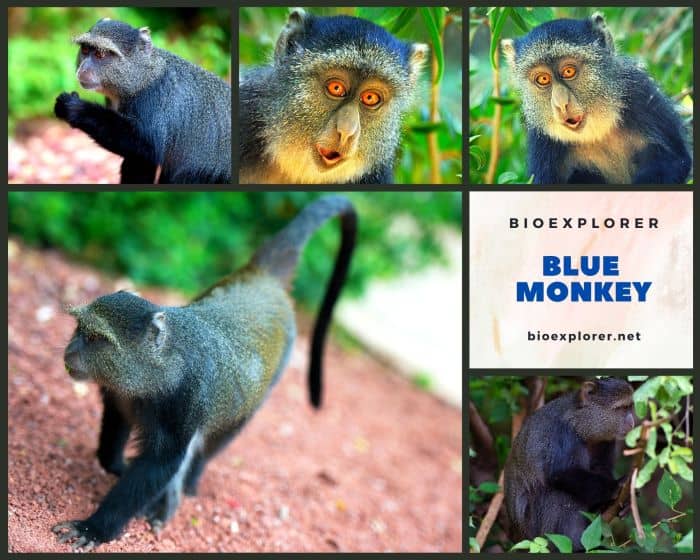
| Animalia | Primates | Cercopithecidae | Cercopithecus | Cercopithecus mitis |
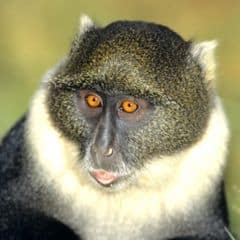

- Common Name: Blue Monkey
- Taxonomy Classification Year: 1822
- Monkey Size: 50 to 65 cm (19.7 to 25.6 in)
- Skin Color(s): Olive or gray
- Habitat: Forest, rainforest, scrub forest
- Diet: Herbivorous
- Native Countries: Angola, Zambia
Blue Monkey Distribution
Blue Monkey Characteristics
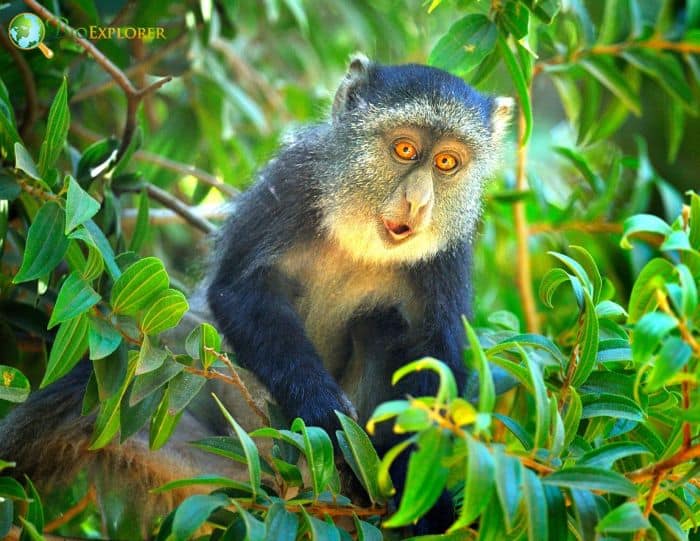
The blue monkey[1] is a species of Old-World monkey endemic to east and central Africa, ranging from the upper Congo Basin east to the East African Rift Valley and south to Zambia and northern Angola.
- Despite its common name, the blue monkey is not visibly blue; it has little facial hair, which often gives it a blue appearance, but it never has the light blue appearance of a mandrill, for instance.
- Instead, it’s mostly olive or gray except for the face (which is dark with a yellowish or pale patch on the forehead), crown, feet, forelimbs, and the mantle, which is gray, olive, or brown, depending on the subspecies.
- Also known as the Samango monkey, this African primate is one of the largest monkey species. They live in evergreen montane tropical forests of Africa, including the Ingeli forest of KwaZulu-Natal. Anatomically, the Samango monkey can grow up to 1.2 to 1.7m long.
- The nostrils of the blue monkey are close together and point downwards. This species of monkey is very vocal and loud.
What Do Blue Monkeys Eat?
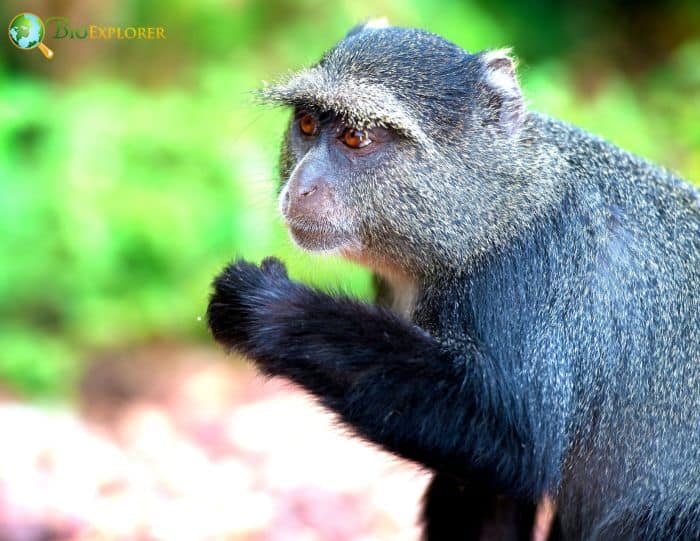
The Blue Monkey consumes many plant materials in the wild, and here are some of them[¶]:
- Siala (Markhamia lutea)
- Forest Ironplum (Drypetes gerrardii).
- Calabash Nutmeg (Monodora myristica).
- Forest Toad-Tree (Tabernaemontana ventricosa).
- Lagos Silkrubbertree (Funtumia africana).
- Ceylon Spinach (Basella alba).
- Fig (Ficus)
- Jasmine (Jasminum)
- Earleaf Nightshade (Solanum um mauritianum).
- Fragrant Dracaena (Dracaena fragrans).
- Triangle Tops (Blighia unijugata).
- Lyre Gurnard (Piper)
- Cape Cheesewood (Pittosporum um viridiflorum).
- Shiny-Leaf (Rhamnus prinoides)
- Largeleaf Lantana (Lantana camara).
- Hill Raspberry (Rubus niveus).
- Coffee (Coffea)
- Treebind (Cissus)
- Num-Num (Carissa spinarum)
- Broom Cluster Fig (Ficus sur).
- Wild Coffee (Psychotria)
- Myrrh (Commiphora)
- Reclining Date Palm (Phoenix reclinata).
- Tree Fuschia (Halleria lucida).
- Leaf Flower (Phyllanthus)
- Scrambling Fig (Ficus burtt-davyi).
- Duiker Berry (Sclerocroton integerrimus).
- Thorny Elm (Chaetachme aristata).
- Oriental Trema (Trema orientalis).
- Chinese Banyan (Ficus thonningii).
- Bladder-Nut (Diospyros whyteana)
- Blackberry (Rubus)
- Cape Holly (Ilex mitis).
- Diamond-Leaved Euclea (Euclea divinorum).
- Red Ironwood (Ochna holstii).
- Persimmons (Diospyros)
- Honeysuckle Tree (Turraea floribunda).
- Tallow Wood (Ximenia americana).
- Mango (Mangifera indica)
- Large Lightning Bush (Clutia abyssinica).
- Duhat (Syzygium cumini)
- Bhankatiya (Solanum torvum)
- Dracaena (Dracaena)
- Sycamore Fig (Ficus sycomorus).
- Silver-Leaved Milkplum (Englerophytum natalense).
- Sugar Apple (Annona squamosa).
- Lemonwood (Xymalos monospora)
- Wild Custard-Apple (Annona senegalensis).
- African Teak (Milicia excelsa).
- Common Asparagus Fern
- African Pencil Cedar (Juniperus procera).
- Chinalaurel (Antidesma)
- Olive (Olea europaea)
- Corrida Yerba De Guava (Geophila repens).
- Wild Peach (Kiggelaria africana).
- Abyssinian Banana (Ensete ventricosum).
- Passionflower (Passiflora edulis)
- Goldenleaf (Chrysophyllum)
- Horsewood (Clausena anisata)
- Lagos Rubbertree (Ficus lutea).
- African Oil Palm (Elaeis guineensis).
- Tamarind (Tamarindus indica)
- Lowveld Fig (Ficus stuhlmannii).
- Aroma (Dichrostachys cinerea)
- Teak (Tectona grandis)
- Baobab (Adansonia digitata)
- Rigid Star Berry (Diospyros squarrosa).
- Milkwood (Tabernaemontana)
- Kirk’s Landolphia (Landolphia kirkii).
- Pod Mahogany (Afzelia quanzensis).
- Chinese Waterberry (Flueggea virosa).
- Garden Tomato (Lycopersicon esculentum).
- East African Copal (Hymenaea verrucosa).
- Chastetree (Vitex)
- African Locust Bean (Parkia filicoidea).
- Natal Orange (Strychnos spinosa).
- Abas (Psidium guajava)
- Jackfruit (Artocarpus heterophyllus)
- Ilang-Ilang (Cananga odorata)
- Pomelo (Citrus maxima)
- Hyphaene (Hyphaene)
- Cantaloupe (Cucumis melo)
- Cashew (Anacardium occidentale)
- Loquat (Eriobotrya japonica)
- Doum Palm (Hyphaene coriacea).
- Capelins (Mallotus)
- Pokeweed (Phytolacca)
- Hackberry (Celtis)
- Boarwood (Symphonia globulifera)
- Sweetwood (Ocotea)
- Mulberry (Morus)
- Ohia (Celtis zenkeri)
- White Star Apple (Chrysophyllum albidum).
- Umbrella-Tree (Maesopsis)
- Red-Fruited Stinkwood (Celtis mildbraedii).
- Sweetgale (Myrica)
What Eats Blue Monkeys?
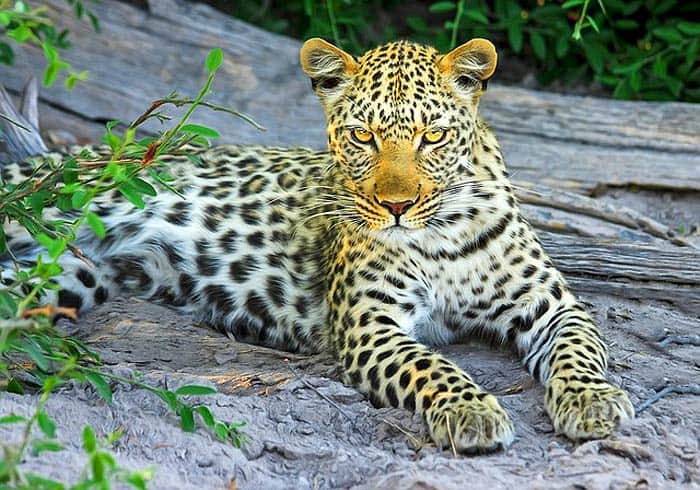
Leopards (Panthera pardus) predate Blue Monkeys[§] in the wild.
Blue Monkey Facts
- The blue monkey is also called the diademed monkey because it has a prominent row of white fur pointing forward just above the forehead line.
- Blue monkeys have cheek pouches that allow them to carry food while foraging.
- Cercopithecus mitis is usually a social species with groups of 10-40 individuals. Groups have a single male social system.
- Found in montane bamboo forests and evergreen forests, the blue monkey lives mainly in the canopy of trees, rarely descending to the ground.
- The species are very territorial, so young males must leave quickly to help each other do better.
Suggested Reading: Types of Monkeys with Names
Cite This Page
APA7MLA8Chicago
BioExplorer.net. (2025, May 28). Blue Monkey. Bio Explorer. https://www.bioexplorer.net/animals/mammals/monkeys/blue-monkey/.
BioExplorer.net. "Blue Monkey" Bio Explorer, 28 May 2025, https://www.bioexplorer.net/animals/mammals/monkeys/blue-monkey/.
BioExplorer.net. "Blue Monkey" Bio Explorer, May 28 2025. https://www.bioexplorer.net/animals/mammals/monkeys/blue-monkey/.











